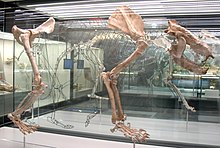| Agriotheriini Temporal range: Tortonian–Gelasian PreꞒ Ꞓ O S D C P T J K Pg N | |
|---|---|

| |
| Skeletal remains of Indarctos arctoides displayed in National Archaeological Museum (Madrid) | |
| Scientific classification | |
| Domain: | Eukaryota |
| Kingdom: | Animalia |
| Phylum: | Chordata |
| Class: | Mammalia |
| Order: | Carnivora |
| Family: | Ursidae |
| Subfamily: | Ailuropodinae |
| Tribe: | †Agriotheriini Hendey, 1972 |
| Genera | |
| Synonyms | |
| |
Agriotheriini is an extinct tribe of ailuropodine bears from the middle Neogene to early Quaternary periods, with fossils found from Eurasia, Africa, and North America.
Taxonomy
The tribe Agriotheriini consists of the three (perhaps four) genera
- Agriotherium
- Huracan
- Indarctos
- Miomaci (possibly).
The taxonomy of these bears has variously placed some of the genera in other bear lineages such as Hemicyoninae and Ursavinae.
Recent papers support their inclusion with giant pandas as members of Ailuropodinae based on diagnostic features like
- large cheek teeth
- parastyle fourth premolar with an enlarged inner lobe
- wide first and second molars being
- high mandible, with respect to the lower tooth row.
They are unlike their closest living relative, the giant panda (Ailuropoda melanoleuca) which evolved into a highly specialized bamboo-eater: The evolution of agriotheriins lead to the group becoming large, hypercarnivorous bears that had adaptations of cursoriality unique in the evolutionary history of bears.
References
- Hunt, R.M. (1998). "Ursidae". In Jacobs, Louis; Janis, Christine M.; Scott, Kathleen L. (eds.). Evolution of Tertiary Mammals of North America. Vol. 1, Terrestrial carnivores, ungulates, and ungulate-like mammals. Cambridge, UK: Cambridge University Press. pp. 174–195. ISBN 0-521-35519-2.
- Jin, C.; Ciochon, R.L.; Dong, W.; Hunt, R.M., Jr.; Liu, J.; Jaeger, M.; Zhu, Q. (2007). "The first skull of the earliest giant panda". Proceedings of the National Academy of Sciences. 104 (26): 10932–10937. doi:10.1073/pnas.0704198104. PMC 1904166. PMID 17578912.
{{cite journal}}: CS1 maint: multiple names: authors list (link) - de Bonis, Louis; Merceron, Juan; Abella, Gildas; Begun, David (October 2017). "A new late Miocene ailuropodine (Giant Panda) from Rudabánya (North-central Hungary)". Geobios. 50 (5–6): 413–421. Bibcode:2017Geobi..50..413D. doi:10.1016/j.geobios.2017.09.003.
- Jiangzuo, Q.; Flynn, J.J.; Wang, S.; Hou, S.; Deng, T. (2023). "New fossil giant panda relatives (Ailuropodinae, Ursidae): A basal lineage of gigantic Mio-Pliocene cursorial carnivores". American Museum Novitates (3996): 1–71. doi:10.1206/3996.1. hdl:2246/7315. S2CID 257508340.
| Extinct members of the family Ursidae | |||||||
|---|---|---|---|---|---|---|---|
| |||||||
| †Hemicyoninae |
| ||||||
| †Ursavinae | |||||||
| Ailuropodinae |
| ||||||
| Tremarctinae |
| ||||||
| Ursinae |
| ||||||
| Category:Prehistoric bears | |||||||
| Taxon identifiers | |
|---|---|
| Agriotheriini | |